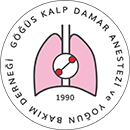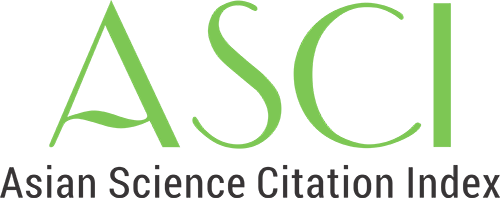

Volume: 25 Issue: 4 - 2020
| 1. | Cover Page I (641 accesses) |
| 2. | Contents Pages II - V (718 accesses) |
| 3. | Subject Issue Pages VI - IX (603 accesses) |
| 4. | Publication Policies and Writing Guide Pages X - XVI (603 accesses) |
| REVIEW | |
| 5. | Aging and Frailty in Cardiac Surgery Elvin Kesimci doi: 10.5222/GKDAD.2019.04934 Pages 223 - 228 (944 accesses) In recent years, biological age has emerged instead of chronological age as a concept that could explain the heterogeneity in outcomes seen in older patients after cardiac surgery and help identify older patients who would benefit from new intervention methods. This review discusses the relationship between fraility concept and postoperative morbidity and mortality in cardiac surgery in elderly patients and the scoring systems in this regard and their utility in predicting postoperative outcomes in clinical practice. |
| RESEARCH ARTICLE | |
| 6. | Factors Affecting Peroperative Blood Transfusion Applications in a University Hospital Gamze Küçükosman, Merve Ezgi Dinçer, Burcu Akkaya, Hilal Ayoğlu doi: 10.5222/GKDAD.2019.70188 Pages 229 - 241 (2198 accesses) INTRODUCTION: In spite of methods to reduce blood use, there are still institutional and personal differences in transfusion applications. The aim of this study was to determine the factors affecting the peroperative transfusion procedures and the frequency of transfusions in our institution, a university hospital. METHODS: The retrospective study was completed with 245 patients who underwent peroperative blood transfusion between January 2017 and June 2017. The efficacy of the patients' demographic characteristics, peroperative Hb values, surgical procedure-part-time, ASA score, anesthesia method, presence of existing hematological pathology, preoperative anticoagulant use and number of additional diseases were evaluated in determining the need for peroperative transfusion. p <0.05 was considered statistically significant RESULTS: The mean age of the patients was 58.09 ± 16.11 years and the duration of surgery was 226.17 ± 125.59 minutes. In the preoperative examination of our patients, 37.1% (n = 91) were anemic, 50.6% (n = 124) were using anticoagulant drugs and 78% (n = 191) had additional disease. It was determined that patients with anemia had more transfusion requirements than those without anemia and 40 (43.9%) of these patients had preoperative, 28 (30.8%) intraoperative and 78 (85.7%) postoperative transfusions. The overall frequency of transfusions was 20.8% preoperatively, 41.6% intraoperatively and 92.2% postoperatively. The mean preoperative Hb level of preoperative transfusions was 10.15 ± 1.86 gr / dl, female sex, ASA 2-3 risk group, diagnosed with anemia and preoperative Hb value 7.1-12.9 gr / dL; The intraoperative-Hb level of intraoperative transfusions was 12.23 ± 2.2 g / dl, advanced age, male sex, long-lasting surgeries, CVS and orthopedic surgeries, ASA 3-4 risk group, general anesthesia, anemia, anticoagulant drug use and comorbidity disease and intraoperative-Hb values of 7.1-12.9 gr / dL and postoperative transfusions were performed in elective conditions, with anemia diagnosis and postoperative-Hb value of 7.1-12.9 gr / dL. DISCUSSION AND CONCLUSION: Transfusion decision is a multidisciplinary decision that needs to be made by evaluating many parameters. It was observed that the transfusion decision was made mostly by the attending physician, 20.8% of the patients underwent preoperative, 41.6% intraoperative and 92.2% postoperatively. We believe that the review of transfusion protocols by all physicians may have an important role in reducing preventable transfusions, and that behavioral changes in transfusion practice will avoid unnecessary transfusions and thus lower risk for patient safety. |
| 7. | The Effects Of Albumin Level And Management of Fluid Replacement on Postoperative Outcome in Cardiac Surgery Nurşen Tanrıkulu, Babürhan Özbek, Ergun Demirsoy doi: 10.5222/GKDAD.2019.07269 Pages 242 - 246 (1648 accesses) INTRODUCTION: Crystalloid sollutions are recommended as first choice for fluid replacement after cardiac surgery. Albumin and synthetic colloids are used in special condition. In this study, the effects of preoperative albumin level on postoperative period and the effects of albumin were investigated. METHODS: Patients who underwent cardaic surgery between 01.01.2014 and 31.12.2018 were evaluated retrospectively. Patients were divided into two groups according to preoperative albumin levels. Patients with preoperative albumin level < 4 g / dl are in Group 1 and ≥ 4 g / dl in Group 2. Effects of preoperative albumin levels on early postoperative morbidity and mortality and its relationship with fluid replacement were evaluated. RESULTS: Hypoalbuminemia persisted in postoperative period in patients with low preoperative albumin levels. During follow-up, 13 patients developed minor complications, of which 12 were in Group 1, and ten had albumin replacement. There were 10 mortality, (9 in Group 1, 1 in Group 2); although 7 of them underwent albumin replacement. It was seen that preoperative albumin value under 4 g / dl increased the risk of postoperative complications 14 times and the application of albumin replacement in these patients did not provide the expected contribution to the outcome. DISCUSSION AND CONCLUSION: Low preoperative albumin value is associated with increased morbidity and mortality in the postoperative period, however, albumin replacement does not contribute positively to the outcome. In accordance with the recommendations of current guidelines, it would be appropriate to consider crystalloid solution as the first choice in cases where blood replacement is not required after cardiac surgery. |
| 8. | Effectiveness Thoracic Ultrasonography to Confirm Position of Double Lumen Endobronchial tube Ali Doğan, Hilal Sazak, Mehtap Tunc, Ali Alagöz doi: 10.5222/GKDAD.2019.62534 Pages 247 - 256 (956 accesses) INTRODUCTION: Hızla yapılabilen ve noninvaziv bir işlem olan toraks USG yöntemi, ÇLT pozisyonunu değerlendirmede klinik olarak karar vermeye katkı sağlayabilir. METHODS: One hundred thirteen patients who required OLV provided by left sided DLT, enrolled in the study. After blind intubation without fiberoptic bronchoscopy (FOB) estimations of RCA and USG methods for accuracy of DLT position were recorded. The conventional evaluation and verification of DLT position was performed in the supine position by using clinical parameters including SpO2> %90, peak airway pressure < 35 cmH2O and plateau airway pressure < 25 cmH2O. While the RCA method was performed by using inspection and auscultation of thorax, the USG method was achieved by evaluating lung sliding and lung pulse. Thoracic USG was performed in all patients after RCA method, without changing DLT position. The predictions of these two methods were compared for the same DLT position. RESULTS: The DLT position prediction of USG method was successful in the rate of 83.2% while it was 77.9 % in RCA method. The sensitivity and negative predictive value (NPV) of USG was higher than RCAs values. The rate of correct DLT position was found 71.7%, while malposition rate was 28.3%. When malposition was considered, DLT was repositioned. While malposition was corrected with a single manipulation in 14 (43.7%) patients, multiple manipulations were needed in 18 (56.3%) patients. If repositioning of DLT was not successful, the placement of DLT was considered as false, and DLT position was corrected with the aid of FOB in 6 (%5.3) patients with supine position. DISCUSSION AND CONCLUSION: Thorax USG method, which is performed rapidly and noninvasively, might aid decision making in confirmation of the DLT position. |
| 9. | Comparıson Of The Effects Of Bupıvacıne And Levobupıvakaın In Lower Extremıty Vascular Surgery Ercan Siyahkoç, Nurgül Yurdseven, İncifer Siyahkoç, Murat Acarel, Suna Yaka doi: 10.5222/GKDAD.2019.30932 Pages 257 - 263 (1358 accesses) INTRODUCTION: The aim of the study was to compare the effects of intrathecal injection levobupivacaine with bupivacaine on hemodynamic parameters, sensorial and motor block duration and side effects in adult patients undergoing lower extremity vascular surgery. METHODS: Our local ethics committee permission and the consent of the patients, the lower extremity vascular surgery will undergo, ASA I-III group, in the age of 25-75 years, 30 patients were randomly selected and included in the study. Patients; Group I (n=15) 17.5mg (3.5ml) isobaric 0.5% bupivacaine, Group II (n=15) 17.5mg (3.5ml) isobaric 0.5% levobupivacaine was randomized as intrathecal injection two groups. All patients were given 10 ml/kg Lactate Ringer infusion and basal values (T0) were recorded. Afterspinal anesthesia hemodynamic parameters were recorded of 2.(T1), 4.(T2), 10.(T3), 20.(T4), 30.(T5), 60.(T6) and 90.minute (T7). In addition, side effects such as nausea, vomiting, itching, respiratory depression, hypotension, bradycardia, arrhythmia, convulsion tremor were recorded. RESULTS: No significant difference was found between groups in terms of heart rate (HR), mean arterial pressure(MAP), and cardiac index(KI) parameters. The goups were similar in terms of sensorial block onset times and sensory block Access to dermotomes and two-segment regressions times and motor block on time. However, motor block regression and motor block up times were found to be shorter in GroupII (p <0.05). None of the patients had ECG changes or side effects.(p>0.05). DISCUSSION AND CONCLUSION: Levobupivacaine, affects hemodinamic in a similar way to bupicaine, it has been concluded that these findings may be used safely in patients with cardiovascular disease potential local anesthetic. |
| 10. | Retrospective Investigation of Brain Death and Organ Donation Cases in a Training and Research Hospital Yasin Uzuntarla doi: 10.5222/GKDAD.2019.98159 Pages 264 - 269 (943 accesses) INTRODUCTION: The objective of this study was to sought retrospectively the brain death and organ donation cases of a training and research hospital between 2009-2018. METHODS: The profile of all cases, brain death numbers and organ donation were evaluated. The patients number, age, sex, nationality, their clinics, diagnosis, the status of donation and the reason of the donation failure, if any, were evaluated. Archives records and the Transplantation, Dialysis and Monitoring Systems of Health Ministry (TDIS) program were used for assestion. RESULTS: We found that brain death of 57 patients was detected and organs of 19 cases (33.3%) were donated. 89.4% of patients (n= 51) were male, 40.3% (n = 23) A blood group, 77,2% (n = 44) in the 20-60 age range, and all cases were citizens of the Republic of Turkey. In terms of hospitalization diagnoses, traumas were the most common with 49.1% (n = 28). 56.2% (n = 32) of the cases were admitted to the intensive care unit of the Anesthesia and Reanimation Clinic. 39.4% (n = 15) found organ donation unacceptable because of religious beliefs. DISCUSSION AND CONCLUSION: Brain death detection numbers and donation rates are not at the desired level. Education and campaigns should be implement to increase the awareness of the health personnel and the society, public spots should be utilized more. More intense activities should be carried out with the Presidency of Religious Affairs that there are no religious problems. |
| 11. | İnvestigation on the effects of melatonin premedication to intraoperative and postoperative hemodynamic parameters, peripheral oxygen saturation, postoperative anxiety and cognitive functions in the patients that in epidural anesthesia Mehmet Kaya, Abdulkadir Yektaş, Abdurahman Çetin doi: 10.5222/GKDAD.2019.55477 Pages 270 - 280 (1455 accesses) INTRODUCTION: Anxiety is a preoperative complication, which most patients encounter. The use of a premedication to reduce preoperative anxiety with minimal cognitive impairment is crucial. This study was conducted to compare the sedative effect of preoperative melatonin in patients with transurethral prostatectomy that performed on the cases decided to apply epidural anesthesia undergoing elective surgery. METHODS: This study was performed on the cases decided to apply epidural anesthesia were selected from among the 80 male patients with transurethral prostatectomy over the age of 60. Patients were divided randomly into 2 groups as 40 people. 6mg melatonin were given to working group Group 1 for preoperative 60 minutes. Premedication was not used in control group Group 2 After applying the epidural catheter to patients, 3 mL 1% lidocain as test dosage was applied from epidural catheter than 12-18 mL 0.5% levobupivacain were applied before preoprative 20 minutes with confirming of the localisation of the catheter. RESULTS: Meaningful difference were determineted between the postoperative HR, SAP, DAP, MAP values when the groups were compared. SpO2 values of Group 1 were determineted meaningfully higher than the group 2 values when groups were compared about peripheral oxygen saturation. The postoperative 1st hour MMT value of Group 1 were determineted meaningfully higher than the postoperative 1st hour MMT value of Group 2 when the groups were compared about MMT values. DISCUSSION AND CONCLUSION: We established that useage of melatonin in patients before epidural block affects positively to cognitive functions and hemodinamic parameters but not any positive or negative effect on anxiety. |
| 12. | Urinary Output During The Aortic Cross-Clamping Period In Isolated Coronary Artery Bypass Grafting Surgery: An Indicator of Postoperative Acute Kidney Injury. Mehmet Yılmaz, Ayse Zeynep Turan, Vildan Kılıç Yılmaz, İpek Yakın Düzyol, Ufuk Aydın doi: 10.5222/GKDAD.2019.65002 Pages 281 - 289 (949 accesses) INTRODUCTION: Postoperative acute kidney injury (AKI) is a common and serious complication of coronary artery bypass grafting surgery (CABG). In this prospective study, we investigated the efficacy of urinary volume during aortic cross-clamping (ACC) in cardiac surgery in determining postoperative AKI. METHODS: This prospective study consisted of patients who underwent isolated coronary artery bypass surgery between January 2016 and April 2017. Patients with an increase of more than 1.5 times preoperative creatinine values on their third postoperative day were considered acute kidney injury according to RIFLE criteria. The patients were divided into two groups as AKI (+) and AKI (-), regarding presence of AKI, which were then compared. RESULTS: Acute kidney damage developed in 12 patients out of 146 patients studied. The demographic variables, intraoperative variables were similar between the groups (p > 0.05). The urinary output during ACC (mL/kg/h) of the AKI (-) group was significantly higher than that of the AKI (+) group (p=0.045). DISCUSSION AND CONCLUSION: Our data demonstrated that urinary output during ACC and cardiopulmonary bypass (CPB) periods may be a valuable criterion for early diagnosis of AKI. We suppose that, the patients with a urine output less than 3.345 ml/kg/h during the ACC period carry a high risk for postoperative AKI. |
| CASE REPORT | |
| 13. | Anesthesia Management in Alcapa Syndrome and The Use Of Intraoperative Transoesophageal Echocardiography Alev Şaylan, Ümit Karadeniz, Feyza Ayşenur Paç, Ajda Mutlu Mıhçıoğlu, Ahmet Vedat Kavurt, İrfan Taşoğlu, Mustafa Paç doi: 10.5222/GKDAD.2019.26566 Pages 290 - 295 (1800 accesses) Anomalous origin of the left coronary artery from the pulmonary artery (ALCAPA) syndrome (Bland-White-Garland syndrome) is a rare congenital coronary artery anomaly characterized by an abnormally located left coronary artery that arises from the pulmonary artery instead of the aorta. Anesthesia induction and maintenance have significance due to many reasons. In the present paper, we aimed to discuss the anesthesia management in this rare syndrome and present case, and to draw attention to share and use the findings of intraoperative transesophageal echocardiography. |
| 14. | Monitoring of the patient with toxic epidermal necrolysis in the intensive care unit Mine Altınkaya Çavuş, Şerife Gökbulut Bektaş, Kemal Özyurt doi: 10.5222/GKDAD.2019.83788 Pages 296 - 302 (3355 accesses) Toxic epidermal necrolysis (TEN) is a disease that usually develops against drugs, has an acute course, involves the skin and mucous membranes, and is accompanied by severe rash. It determines the prognosis of the disease and naturally the mortality rate. The most important steps of treatment; early diagnosis and immediate discontinuation of suspected drugs.59 years old female patient with TEN was managed successfully in the intensive care unit. |
| 15. | Completion Of Septoplasty Operation Despite Decreased Oxygen Saturation In A Patient With Rainier Hemoglobinopathy With General Anesthesia Yahya Yıldız, Mine Özen Akay, Yaşar Gökhan Gül, Yavuz Demiraran doi: 10.5222/GKDAD.2019.86158 Pages 303 - 306 (969 accesses) Rainier hemoglobinopathy is an extremely rare hematologic disorder characterized with increased oxygen affinity of hemoglobin leading low blood oxygen saturation. Up to date literature includes only 1 case whom had been operated with general anesthesia. In this report, we present a 27-year-old male patient with rainer hemoglobinopathy whom underwent nasal septoplasty with general anesthesia. |

















